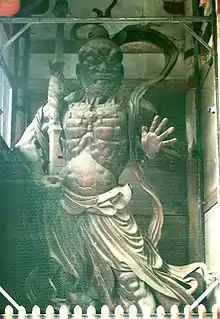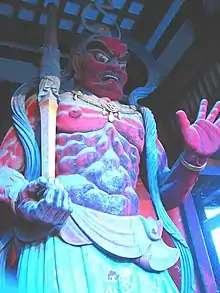Nio
Niō (仁王) or Kongōrikishi (金剛力士) are two wrathful and muscular guardians of the Buddha standing today at the entrance of many Buddhist temples in East Asian Buddhism in the form of frightening wrestler-like statues. They are dharmapala manifestations of the bodhisattva Vajrapāṇi, the oldest and most powerful of the Mahayana Buddhist pantheon. According to Japanese tradition, they travelled with Gautama Buddha to protect him and there are references to this in the Pāli Canon as well as the Ambaṭṭha Sutta. Within the generally pacifist tradition of Buddhism, stories of dharmapalas justified the use of physical force to protect cherished values and beliefs against evil. The Niō are also seen as a manifestation of Mahasthamaprapta, the bodhisattva of power that flanks Amitābha in Pure Land Buddhism and as Vajrasattva in Tibetan Buddhism.[1]
Manifestations
Kongōrikishi are usually a pair of figures that stand under a separate temple entrance gate usually called Niōmon (仁王門) in Japan, hēnghā èr jiàng (哼哈二将) in China and Geumgangmun (金剛門) in Korea. The right statue is called Misshaku Kongō (密迹金剛) and has his mouth open, representing the vocalization of the first grapheme of Sanskrit Devanāgarī (अ) which is pronounced "a". The left statue is called Naraen Kongō (那羅延金剛) and has his mouth closed, representing the vocalization of the last grapheme of Devanāgarī (ह [ɦ]) which is pronounced "ɦūṃ" (हूँ). These two characters together (a-hūṃ/a-un) symbolize the birth and death of all things. (Men are supposedly born speaking the "a" sound with mouths open and die speaking an "ɦūṃ" and mouths closed.) Similar to Alpha and Omega in Christianity, they signify "everything" or "all creation". The contraction of both is Aum (ॐ), which is Sanskrit for The Absolute.

Misshaku Kongō or Agyō
Misshaku Kongō (密迹金剛), also called Agyō (阿形, "a"-form, general term open-mouthed statues in aum pair), is a symbol of overt violence: he wields a vajra mallet "vajra-pāṇi" (a diamond club, thunderbolt stick, or sun symbol)[2] and bares his teeth. His mouth is depicted as being in the shape necessary to form the "ah" sound, leading to his alternate name, "Agyō". Misshaku Kongō is Miljeok geumgang in Korean, Mìjī jīngāng in Mandarin Chinese, and Mật tích kim cương in Vietnamese. It is equivalent to Guhyapāda vajra in Sanskrit.[3]
Naraen Kongō or Ungyō
_at_Hwa-Eom_Temple-.jpg.webp)
Naraen Kongō (那羅延金剛), also called Ungyō (吽形, "um"-form, general term closed-mouthed statues in aum pair) in Japanese, is depicted either bare-handed or wielding a sword. He symbolizes latent strength, holding his mouth tightly shut. His mouth is rendered to form the sound "hūṃ" or "Un", leading to his alternate name "Ungyō". Naraen Kongō is Narayeon geumgang in Korean, Nàluóyán jīngāng in Mandarin Chinese, and Na la diên kim cương in Vietnamese.[3]
Shukongōshin

A manifestation of Kongōrikishi that combines the Naraen and Misshaku Kongō into one figure is the Shukongōshin at Tōdai-ji in Nara, Japan. Shukongōshin (執金剛神), literally "vajra-wielding spirit", is Shūkongōshin or Shikkongōjin in Japanese, Jip geumgang sin in Korean, Zhí jīngāng shén in Mandarin Chinese, and Chấp kim cang thần in Vietnamese.[3]
Nio Zen Buddhism
Nio Zen Buddhism was a practice advocated by the Zen monk Suzuki Shōsan (1579–1655), who advocated Nio Zen Buddhism over Nyorai Zen Buddhism. He recommended that practitioners should meditate on Nio and even adopt their fierce expressions and martial stances in order to cultivate power, strength and courage when dealing with adversity.[4] Suzuki described Nio as follows: "The Niō (Vajrapani) is a menacing God. He wields the kongōsho (vajra) and he can crush your enemies. Depend on him, pray to him that he will protect you as he protects the Buddha. He vibrates with energy and spiritual power which you can absorb from him in times of need."
Influence on Taoism
Nio were also introduced into Chinese Taoism as Heng Ha Er Jiang (哼哈二将). Within the Taoism novel Fengshen Yanyi, Zheng Lun and Chen Qi were finally appointed as the two deities.[5]
See also
- Buddhist and Greco-Buddhist art
- Buddhist temples in Japan
- Door gods, for similar protective East Asian deities
- Greco-Buddhism
- Jaya-Vijaya
- Korean Buddhism
- Vajrapani and Skanda
Notes
- The illustrated encyclopedia of Zen Buddhism By Helen Josephine Baroni, Page 240
- See "金剛" at William Edward Soothill and Lewis Hodous. A Dictionary of Chinese Buddhist Terms Archived 2006-12-06 at the Wayback Machine
- Transliterations from Digital Dictionary of Buddhism
- Helen Josephine Baroni (June 2002). The illustrated encyclopedia of Zen Buddhism. The Rosen Publishing Group. p. 240. ISBN 978-0-8239-2240-6. Retrieved 26 March 2012.
- Fengshen Yanyi, chapter 99.
References
- Religions of the Silk Road by Richard Foltz, 2nd edition (Palgrave, 2010) ISBN 9-780230-621251
- The Diffusion of Classical Art in Antiquity by John Boardman (Princeton University Press, 1994) ISBN 0-691-03680-2
- Old World Encounters. Cross-cultural contacts and exchanges in pre-modern times by Jerry H.Bentley (Oxford University Press, 1993) ISBN 0-19-507639-7
- Alexander the Great: East-West Cultural contacts from Greece to Japan (NHK and Tokyo National Museum, 2003)

_and_right_(Agy%C5%8D)_of_the_sanmon_gate_at_Zents%C5%AB-ji_in_Zents%C5%AB-ji_City_Kagawa_pref.jpg.webp)

